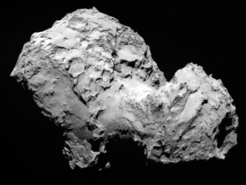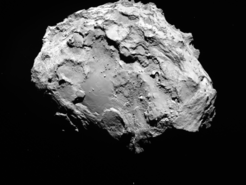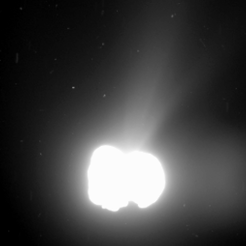Finally there! Rosetta arrives at 67P
Images of comet Churyumov-Gerasimenko show a diversified world of bizarre beauty.
ESA's space probe Rosetta has reached the destination of its more than ten year long journey through space. At 11.30 AM (Central European Time) ESA's control station in Darmstadt (Germany) picked up the long awaited signal: Rosetta has arrived at the comet 67P/Churyumov-Gerasimenko. The most recent images taken by the onboard scientific imaging system OSIRIS on August 3rd reveal a world of bizarre beauty – with steep slopes, prominent pits, and wide planes.
“We have been approaching 67P for such a long time, it is almost surreal to now actually be there“, says OSIRIS Principal Investigator Holger Sierks from the Max Planck Institute for Solar System Research (MPS) in Germany. “Today, we are opening a new chapter of the Rosetta mission. And already we know that it will revolutionize cometary science“, he adds.

With a spatial resolution of 5.5 meters per pixel, the most recent images that were obtained from a distance of 285 kilometers above 67P's surface surpass all pictures earlier space missions had taken of cometary surfaces. „It's incredible how full of variation this surface is“, Sierks says. „We have never seen anything like this before in such great detail.”

Apart from the strong variations in albedo found on the surface, especially the many sharp-edged structures are tantalizing. The images show steep precipices and eye-catching protruding structures. In addition, the surface exhibits areas that seem almost smooth. „It's too early to tell, whether these planes are really smooth“, says Sierks. „The current images only show that the surface structures there are smaller than our current resolution.”
The scientists assume that the comet's activity formed these bizarre landscapes. When on their orbit through the solar system comets approach the Sun, volatile substances escape from their surface tearing jets of dust with them. If these particles are too heavy or too slow to leave the body's gravitational field, they sink back to the surface where they are locally re-deposited. Comet 67P is believed to have passed through the inner solar system only a few times before. The next months will show, whether the structures now becoming visible were truly formed during these advances.

In the next months, Rosetta will come closer than 10 kilometers to the comet’s surface. One of the main goals will be to search for an appropriate landing site for the Philae lander. Philae is scheduled to touch down on the surface in the autumn of this year. Even afterwards, Rosetta will accompany „her“ comet until the end of 2015. „We will have the unique opportunity to witness, how the comet's activity forms and changes its surface“, says Sierks.
Rosetta is an ESA mission with contributions from its member states and NASA. Rosetta's Philae lander is provided by a consortium led by DLR, MPS, CNES and ASI. Rosetta will be the first mission in history to rendezvous with a comet, escort it as it orbits the Sun, and deploy a lander to its surface.
The scientific imaging system OSIRIS was built by a consortium led by the Max Planck Institute for Solar System Research (Germany) in collaboration with CISAS, University of Padova (Italy), the Laboratoire d'Astrophysique de Marseille (France), the Instituto de Astrofísica de Andalucia, CSIC (Spain), the Scientific Support Office of the European Space Agency (The Netherlands), the Instituto Nacional de Técnica Aeroespacial (Spain), the Universidad Politéchnica de Madrid (Spain), the Department of Physics and Astronomy of Uppsala University (Sweden), and the Institute of Computer and Network Engineering of the TU Braunschweig (Germany). OSIRIS was financially supported by the national funding agencies of Germany (DLR), France (CNES), Italy (ASI), Spain (MEC), and Sweden (SNSB) and the ESA Technical Directorate.


